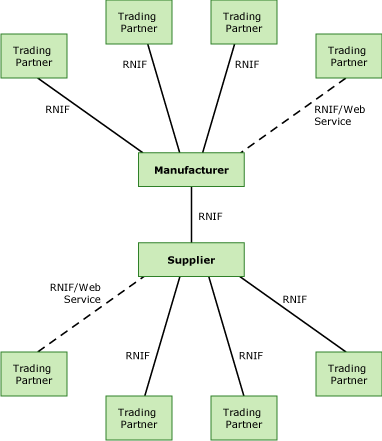The Supply Chain Solution
Technology can help solve the business challenges related to business process and data communications. Information Technology (IT) systems can help high-technology companies transform the communications with their partners from disconnected, incompatible processes to integrated, standardized ones.
Supply Chain Integration
Even if the processes of the separate partners in a supply chain are not compatible, you can integrate them. You can tie them together with technology that transforms a system characterized by a variety of customized connections to one based on a single, standard connection. For an example of such a solution, see the following figure, and compare it to the system shown in the figure in The Supply Chain Challenge.

In this system, the standard interface between trading partners is a RosettaNet Implementation Framework (RNIF) connection. The system is a RosettaNet-compliant implementation that replaces all the custom and manual interactions with automated RNIF connections. This does not prevent companies from customizing their systems, creating their own agreements with their partners, or using other communication devices when they want or have to. This system gives partners the flexibility to customize the system for their own purposes. However, it does mean that all partners use consistent processes for their routine data communications.
All companies in this supply chain share an RNIF connection. For a large company, you can set up a fully automated enterprise system using MicrosoftBizTalk Server and BizTalk Accelerator for RosettaNet (BTARN). You can also enable a trading partner to use whatever RosettaNet-compliant implementation they already have installed, or continue using an EDI system. A small company, on the other hand, might not have the resources for a full BTARN system. For them, you can set up a Web service that enables them to connect to the supply-chain system. In this case, the only technology requirement is a Web browser. In each of these cases, all companies in the system take advantage of a unified approach to connecting with their partners.
The Benefits of Standardization
Companies can exchange data by electronic means without participating in a fully integrated system. However, if the data maintained by separate trading partners is in different formats, and their systems transport it though different data protocols, the data exchange can require a significant effort to design and customize. You can greatly enhance the efficiency of business transactions if each connected partner standardizes the format and protocol used with their data exchange.
The RosettaNet organization has created standards that define how partners exchange messages over the Internet (RNIF) and how partners structure the content of the messages—Partner Interface Processes (PIPs). RosettaNet-ready certification ensures interoperability. If an integration solution is RosettaNet certified, you can extend it to multiple partners. It can handle existing solutions, whether they are integration technologies, such as EDI, or back-end systems, such as Oracle and SAP.
RosettaNet standards focus on the specific needs of the high-technology manufacturing industry. When all partners in a supply chain base their schemas and message processing on the same standards, they reduce the overall effort, cost, and risk associated with their data exchange, and they obtain a system that meets their specific needs.
Visibility and Cost
With an integrated system, you can connect to each partner, providing the mechanisms that bind their processes together and resolving their differences. An integrated system automates data exchange according to industry standards, so that business processes can run with a minimum of human intervention. This provides commonality to your communications, and lets you reap the benefits of your technology investments.
With an integrated system, you have better visibility into your inventory positions throughout your supply chain. You can gauge demand more quickly and accurately, and respond to trends. You can determine where an order is in the supply chain, and accurately assess the health of the system.
With increased visibility into the end-to-end supply chain, you can reduce your costs by decreasing inventory, increasing inventory turns, and decreasing freight costs. With an automated system, you can increase employee productivity and reduce costs by reducing manual data entry and error corrections. Because of an increased reliance on automated processes, you can reduce other communications costs.
See Also
Sample Supply Chain Scenario
The Supply Chain Challenge
The Need for Trading Partner Integration